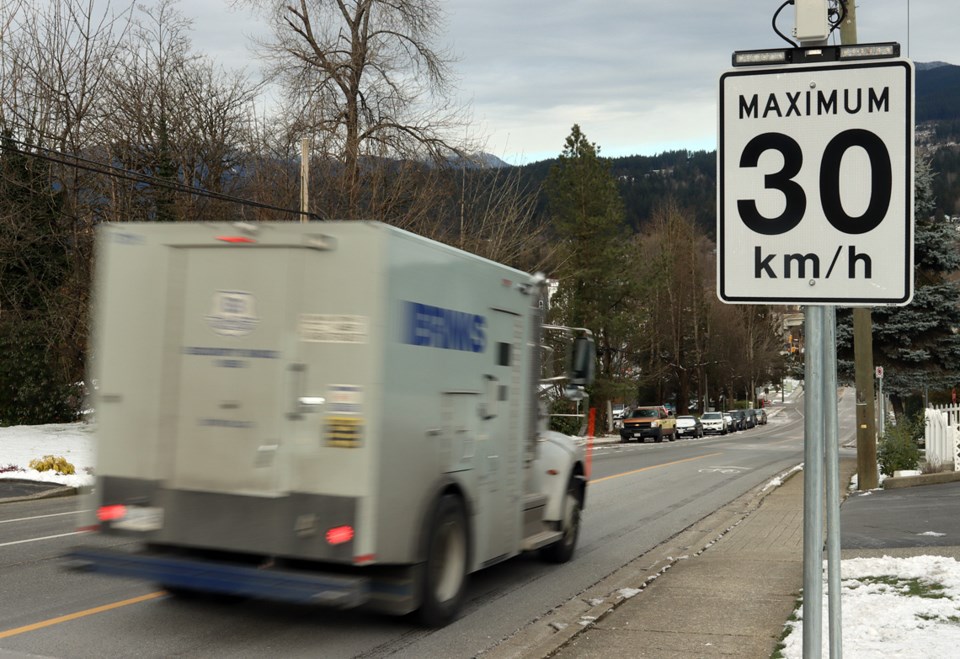Residents living along Port Moody’s Moray Street are confident a plan to slow traffic speeding down and up the steep connector to Coquitlam will make their neighbourhood safer.
The plan, which includes curb extensions to narrow lanes, raised medians to create slight chicanes that drivers will have to slow to navigate and more on-street parking for residents to act as a buffer to passing vehicles, was approved by council Tuesday.
It will begin as a pilot project with temporary plastic delineators and yellow plastic curb units, new markings on the pavement and signs.
A new pedestrian crosswalk with flashing lights will also be installed at Pinda Drive.
Jason Ashfield, who’s lived on Moray for three years, said he has little doubt the plan will be effective.
“It solves the old issue of Moray Street being very steep and straight,” he said. “It does a great job of slowing drivers as they come down the hill.”
Ashfield said traffic calming measures put in place in 2020 when the street was repaved didn’t have the desired effect.
They included the elimination of curbside parking on the northbound side of the street, as well as a painted bike lane on the southbound side.
Instead, Ashfield said, pedestrians felt even more uncomfortable and unsafe as the measures crowded passing traffic right up to the sidewalk on the northbound side of the busy road that is used by about 7,000 vehicles a day.
“Traffic calming has not kept up with traffic,” he said.
Port Moody’s general manager of engineering and operations, Jeff Moi, admitted there were missteps.
But transportation engineer Geoffrey Keyworth said the new plan is much more refined and involved considerable consultation with residents in the neighbourhood.
He said the results of virtual meetings with residents as well as a postcard campaign that received 120 responses showed people didn’t feel safe walking, cycling or even driving up and down Moray.
They also wanted better facilities for crossing the street.
Keyworth said further ideas, like the installation of four-way stops at some intersections with side streets, were rejected as they’d likely create more problems than they’d solve, such as backing up traffic turning off St. Johns onto Moray.
He also worries they might result in more rear-end collisions.
Instead, curb extensions that create a bulge at intersections and a buffer to flanking sidewalks will not only have the effect of slowing traffic because of the narrower lanes on Moray, they’ll also give drivers coming off side streets a better view up and down the hill as they’ll have more room to edge out past roadside obstructions like trees.
Several councillors praised the new plan.
Coun. Diana Dilworth said it might even encourage drivers to find another route between Port Moody and Coquitlam, making the neighbourhood even more peaceful and safe.
But Coun. Zoe Royer worried the narrowness of Moray could present challenges for drivers and city crews when the weather turns cold and the pavement gets icy.
Keyworth assured her the plan’s design took winter maintenance into consideration while Moi added the curb extensions mean plows will no longer push snow right up onto the sidewalk along Moray’s east side.
The pilot project is expected to cost $70,000. It will be evaluated in November, and could include further input from residents through an online survey.
If the measures become permanent, construction of concrete medians and curb extensions, as well as the installation of better lights along the street, is estimated to cost about $720,000.
In the meantime, Keyworth said, the city will continue work to identify alternate cycling routes that will connect with Coquitlam’s desire to route cyclists a little further east from Moray and Thermal Drive along Clearview Drive, Park Crescent and Corona Crescent as they make their way up toward Como Lake Avenue.



